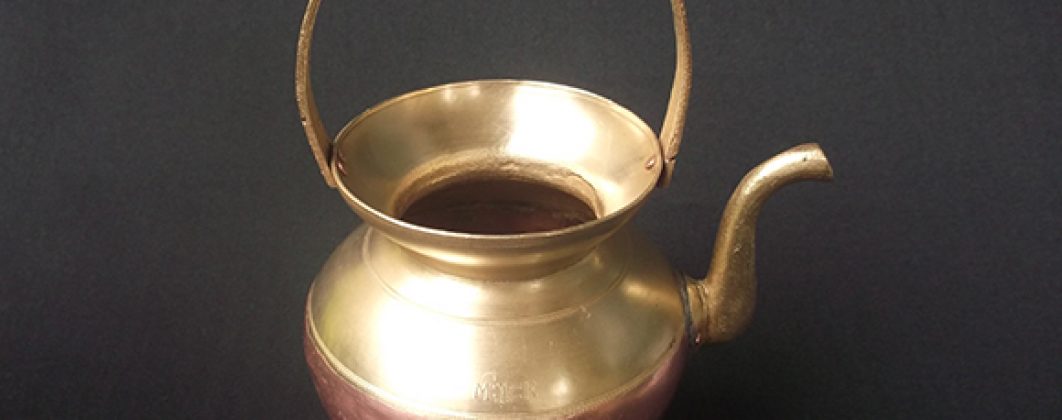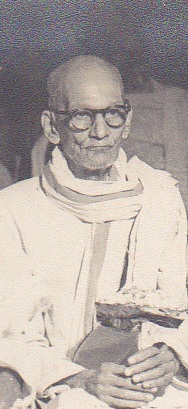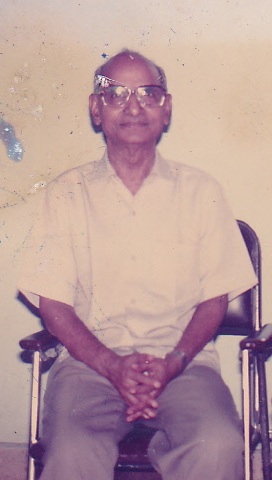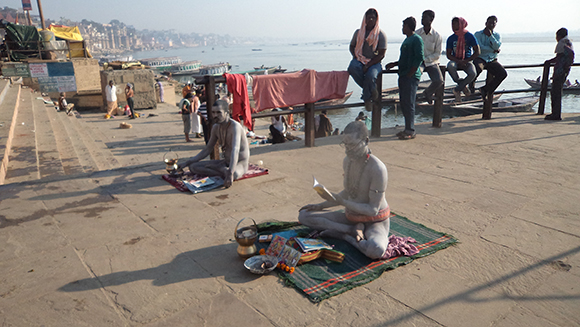
Kamandalam is a water pot with a handle used by Hindu religious sadhus, sanyasis, munis, yogis, ascetics, Buddhist monks and Hindu mendicants to carry water. Kamandalam represents a self-contained and simple life. Kamandalam is also called as Kamandal or Kamandalu. It is traditionally made out of ripe bottle gourd, or pumpkin, or coconut shell, or from wood of the Kamandalataru tree. It is said that the water in a traditional pumpkin Kamandalam is equivalent to Amrutam, the elixir of life; hence it represents life, continuity, fertility, and prosperity. It is depicted that Hindu Gods and sanyasis carry the traditional Kamandalam in their hands. Nowadays, Kamandalam is made out of Brass, Copper, or Silver and also with Clay. I have collected a unique and beautiful Kamandalam made out of the combination of brass and copper.
My Early Experience with Kamandalam
I have childhood memories of Kamandalam being used profusely in our village Someswaram in the Godavari delta in Andhra Pradesh, India. Hindu religious sanyasis used to come to our village and they used to visit few houses and collect rice in their shining brass Kamandalam till it is full. Once it is full, they used to go under the Pipal tree near the tank of the village and cook the rice for their mid-day meal. I used to admire the shining Kamandalam vessel in their hands.


The Brahmins in our village used to carry Kamandalam with the water to the temple to do Abhishekam to the Sivalingam in our Someswara Swami temple. Abhishekam is a form of pooja ritual to the God in which he is drenched with water by slowly pouring water on the entire body of the God starting from the head till the toe. Lord Shiva is known as Abhisheka priya (lover of abhishekam) and hence most of the people do Abhishekam to Lord Shiva in his Lingam form with devotion and tender care from the snout of the Kamandalam.
The History of the Kamandalam

The Kamandalam shown in the picture belongs to my paternal grandfather and he used it for doing Abhishekam in our village Shiva temple. I was told by my mother that my grandfather Shri. Yenugu Krishna Murthy has purchased this Kamandalam at Kasi, presently known as Varanasi, during his pilgrimage to various holy places In India in the year 1927. So we can say that this Kamandalam is 85 years old. After my grandfather’s death, this has come to my possession as a part of my antique collection. Since it is just decorating my shelf, my father- in- law Shri. Machraju Bhaskar Rao, started using the Kamandalam to do Abhishekam on every Masa Sivarathri day to Lord Shiva in the city of Vijayawada. The short form of his name “M.B.R.” is also engraved on the Kamandalam so that it can be easily identified among the several Kamandalams that come to the temple for Abhishekam.



The poojari (temple priest) collects all the Kamandalams with water; he does the abhishekam and then returns the Kamandalams to the respective persons. After my father-in-laws demise, the Kamandalam has again come back to my collection. I really don’t know how many times this Kamandalam served Lord Shiva by being an instrument in doing abhishekam to Shiva from its beautiful snout.
The Design of the Kamandalam
Here are the measurement of the Kamandalam: Height from base to mouth: 5 inches, from base to the handle: 8 inches, diameter of the base: 2.8 inches, diameter of the belly 4.5 inches, diameter of the mouth: 3.4 inches.




This Kamandalam is hand made with brass and copper and this is a beautiful combination, aesthetically speaking. This Kamandalam is called Ganga Jamuna Kamandalam since the brass in it represents Ganga river and the copper represents Jamuna river (also know about Ganga Jamuna pot in the article “Ganga Water Lota” written by me). The Kamandalam has a three stepped base, a round shaped pot and a wide open neck. All the three elements of the pot are exquisitely blended to form a lovely curvaceous pot. There is a graceful snout resembling the neck of a peacock attached to the belly of the Kamandalam through which water can be poured in a controlled way. There is a beautiful semi-circular handle attached to the mouth of the Kamandalam to facilitate excellent grip when carried and to monitor the flow of the water from the snout in a measured way.




Traditional Kamandalam
Traditional Kamandalam is made out of bottle gourd or pumpkin or coconut. The ripe pumpkin is removed from the creeper and is sun dried. After the skin becomes dry, the inside flesh along with the seeds is scooped out keeping the skin intact. The skin is cleaned thoroughly from inside. Subsequently, the skin is cut into the shape of Kamandalam with a handle.
The Spiritual Significance of making Pumpkin Kamandalam
The pumpkin creeper plant is compared to the material world and the pumpkin to the individual. The seeds and the flesh of the pumpkin are symbolised as ego. The individual has to cut himself off from the material world like the pumpkin is plucked out from the plant. One has to scoop out his ego and carnal desires to clean his inner self to attain moksha, the celestial bliss, just as the way the flesh is removed from the pumpkin and the skin is cleaned. As the dried pumpkin is fit to hold the water which is equivalent to Amrutam, so is the mind which is fit to enjoy celestial bliss. The desires can be removed from the mind by Yogic practices similar to the cleaning and drying the skin of the pumpkin. Thus, the mind is filled with celestial joy as the Kamandalam is filled with nectar.
Stories about Kamandalam
In Hindu puranas and epics, there are stories signifying the importance of Kamandalam. It is interesting to know some of these stories.
The Story of Agastya muni and Cauvery River
For the marriage of Lord Shiva with Parvathi all the Gods, Devatas, Rishis, and Munis were present to witness the wedding. Due to the weight of such large gathering, the north part of India got tilted down. In order to balance the earth, Lord Shiva asks Agastya Maha Muni to go to the Podhigai mountain ranges in the south of India. Rishi Agastya, though being short statured had immense spiritual strength and was the only person who could maintain the balance. Agastya muni was unhappy that he could not witness the divine marriage. So Lord Shiva granted him the divine vision to witness the marriage from wherever he is. Lord Shiva also took a hair from his thick locks and converted it into a river called Kaveri and commanded her to be in the Kamandalam of Agastya rishi and that she should flow out when directed by Agastya.
Indra, the king of Devas, afraid of the demon Surapadman left his abode and reached Sirgazhi, located in the southern part of India to hide himself and to pray to Lord Shiva. He created a beautiful garden and was performing pooja to Lord Shiva from the flowers of the garden. Varuna, the God of rain, afraid of Surapadman, stopped giving rain water to Indra’s garden and hence Indra could not do his pooja with the flowers. Indra approached Lord Ganesha and requested his help. Ganesha disguised as a boy came to Podhigai ranges where Agastya rishi was living and sat on his Kamandalam and tilted it so that water could flow out. When Rishi Agastya lifted his hand to shoo off the crow, Kaveri river took it as a signal for her to flow and it flowed in the direction where Indra’s garden is located and watered his garden. Agasthya Maha Muni started chasing the boy and Lord Ganesha gave his darshan as Ganesh. Agastya was very repentant that he tried to punish Lord Ganesha and as repentance started hitting his forehead with his knuckles. Lord Ganesha blessed Agastya rishi and gave a boon to him stating that whoever worships him by beating his forehead with knuckles will attain wisdom and victory in their life. Thus, the Kamandalam is instrumental in carrying river Kaveri to south of India.
The Story of Vamana and Bali
Mahabali was a great Asura king and he conquered both earth and heavens and had driven Indra from his Kingdom of Heavens. Bali was the son of Prahlada and Prahlada’s father was Hiranyakasapu. Indra, being helpless prayed to Lord Vishnu to restore his kingdom of heavens. Lord Vishnu took incarnation as Vamana Avatara to dethrone King Bali and restore heavens to Indra. Lord Vishnu was born to Rishi Kasyapa and his wife Aditi as Vamana. He grew as a dwarf Brahmin. One day, the dwarf Vamana goes to King Bali with a grass umbrella and a Kamandalam in his hands and asks a boon from him to grant three feet of land. Sukracharya who is the guru of Bali and all Asuras sensed that Lord Vishnu has come in disguise as Vamana and was apprehensive of some foul game. Sukracharya requested Bali not to grant any boon as Lord Vishnu had come in the avatar of Vamana. But Bali insisted on giving the boon since he had already committed. Vamana asks Bali to sanctify the boon by pouring water into his hands from his Kamandalam. Bali takes the Kamandalam into his hands from Vamana to pour water.
To prevent the boon being sanctified, Sukracharya enters into the spout of the Kamandalam in the form of a bee and prevents the flow of water from it. Vamana guessed the play of Sukracharya and cleared the way of the snout by piercing a Dharba grass which blinds the eye of Sukracharya. Vamana then takes the form of Trivikrama and enlarges his form into gigantic proportions in such a way that one leg is kept on the earth and another on the heaven and then he asks Bali where he should keep his third foot. Bali offers his head and Vamana puts his foot on the head of Bali and pushes him to Pathala Loka, the netherworld. He then grants a boon to Bali that he can come to earth and visit his kingdom once in a year and that day will be celebrated as Onam festival. The people of Kerala welcome Bali every year by celebrating Onam festival with floral decorations in front of each house, song and dance, boat races, and of course the most important feast with 21 course meal. Thus, Vamana’s Kamandalam plays an important role in sanctifying the boon granted by King Bali and blinding the eye of Sukracharya.
The Story of Satyavrata and Matsyavatara
It is said in Bhagavata Purana that King Satyavrata saved a fish from the big fish by keeping it in his Kamandalam. This fish was Lord Vishnu in his Matsyavatara form. The same Matsya takes a gigantic form and saves Satyavrata from a great deluge. The fish tells Satyavrata to build a boat, and sit in it along with Sapta Rishis. At the time of deluge, the great Matsya pulls the boat to safety and saves Satyavrata from the great deluge of Kalpantara and he lives in the next kalpa or the post deluge era. For full story of how Satyavrata is saved by Lord Vishnu in his Matsyavatara, please read the article “Antique Brass Tiruchoornam Bharani (container)” written by me.
The Story of Ksheera Sagara Madhanam (Churning of milky ocean ) by Devatas and Asuras
It is written in the Mahabharata that Devatas and Asuras churned the milky ocean to obtain Amrutham, the elixir of life. Dhanvantari comes out of the ocean with a Kamandalam in his hand full of Amrutham. Both Devatas and Asuras fight for Amrutham. Lord Vishnu appears in the guise of a beautiful and enchanting woman called Mohini, tricks Asuras and distributes the Amrutham to Devas only from the Kamandalam. For the full story on churning of the milky ocean (Pala Samudra Madhanam) and how Mohini tricks Asuras and favours Devas, please visit the article “Maha Kumbh Mela” written by me.


Gods and Goddesses who hold Kamandalam in their Hands
Goddess Durga – Goddess Durga is worshipped in nine forms as Navadurga in the Navaratri pooja festival. Out of the nine forms, one form is known as Brahmacharini. In this form, Goddess Durga is depicted as the one who practices austerity, bestows happiness, prosperity, peace and grace. She holds Kamandalam in one hand and a rosary in another hand.
Lord Shiva – In front of Shiva (in the centre), a Kamandalam made from the pumpkin is always shown on the ground. The pumpkin Kamandalam contains nectar and is a symbol of spiritual attainment. Kamandalam also signifies the simple and detached life of Lord Shiva.
Dattatreya – Lord Dattatreya was born to Rishi Athri and his wife Anasuya. He has six hands and in one of the hands he holds Kamandalam. The water in Dattateya’s kamandalam is of highest purity and can cure mental and physical ailments.
Lord Brahma – Lord Brahma is depicted as having four arms. In the top left hand, he carries Vedas, in the top right hand he holds a rosary which he uses to count time, in the lower right hand he gives Abhayamudra that is protection for his all devotees and also bestows divine grace on his entire creations, in the lower left hand he holds a Kamandalam and the it represents cosmic energy out of which the universe is created.
More about Gods and Kamandalam

Copyright © 2021 YK Antiques Home Museum
9 Responses
Where all I get this?I would like to be one
where can i get this?please send me any shop details
Dear Mr.Krishnamurthy,
I would like to buy a new Kamandalam. Where can I?Namasthe
Sir
I need to buy the Ganga Jamuna Kamndalam through online. Please help me in this regard..
Thank you Sir…
Sir
I have a Brass Kamandalam and Brass Kindi. After reading your articles, I have proudly displayed them at the Display Shelf of my hall.
Regards
U.Viswanathan